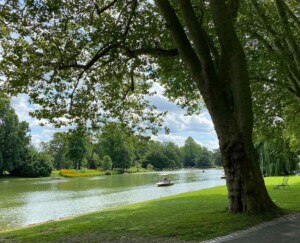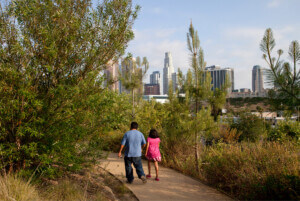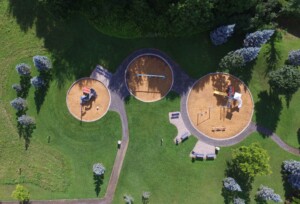Today, pocket parklets popped up across the country for Rebar Group‘s 2017 PARK(ing) Day – now a beloved tradition among public space enthusiasts and designers.
According to the PARK(ing) Day Manual, the celebration treats metered parking spots as a “short-term lease for a plot of precious urban real estate.” In place of parked cars, a range of creative interventions abound. This year, the American Society of Landscape Architects asked landscape architects all over the country to invest their quarters on temporary, miniature green spaces. Here are some of our favorites from the #ASLAPD17 hashtag on social media.
Site Design Group in Chicago built a human-powered hamster wheel, albeit with one glaring design flaw: the absence of an attached grass smoothie machine.
Pssst… it's a human-sized hamster wheel for Park(ing) Day! #ASLAPD17 #PARKingDay #landarch #chicago pic.twitter.com/02ADB76UCd
— site design group (@sitedesigngroup) September 15, 2017
In Baltimore, Hord Coplan Macht constructed a peaceful little greenspace with terraced timber seating.
https://twitter.com/MiguelIraola/status/908751817143721985
D.C.’s Landscape Architecture Bureau (LAB) built a small field of artificial tulips from plastic taken from the Anacostia Watershed.
@AnacostiaRrkper check out @LABinDC PARKing Day design in #navyyard built from recovered plastic bottles from #anacostiawatershed #aslapd17 pic.twitter.com/PkGQMq23cE
— Katie Riddle (@KatiePavRiddle) September 15, 2017
L.A.’s AHBE LAB privileged the deep thatch in a rewilding of a parking space recalling Agnes Denes’ 1982 Wheatfield in Battery Park Landfill.
#PARKingDay is here! Thx for posts of AHBE's Re-Wilding of #DTLA. Here's 2 #AHBEppl wilding it. #aslapd17
More: https://t.co/W0PIabHYt5 pic.twitter.com/ceXXZLWytB— AHBE | MIG (@ahbeland) September 15, 2017
From Instagram, Seattle’s Weisman Design Group created seesaws and tetherballs amid tall grasses that we really wish were permanent.
The ASLA’s branch at Arizona State University in Tempe, Arizona constructed a lovely raised topographic seating area.
https://www.instagram.com/p/BZEw2TXlNUZ/?taken-by=asu_asla
Finally, in Austin, Texas, Daniel Woodroofe Group put up a hedge public hammocks.
Other parklets are permanent.
As The New York Times reported in late August, 18 curbside pop-up spaces have appeared across New York City alone (double last year’s count), and they’re here to stay. Most of these spaces have been created through a partnership between the city’s Transportation Department and local groups, including the Parsons School of Design, which created a flexible space called Street Seats with planters constructed of bamboo and movable seating.
PARK(ing) Day has catalyzed similar programs nationwide. Regardless of its permanence, parklets remain a charming, temporary form of urban acupuncture expanding public and green space.










